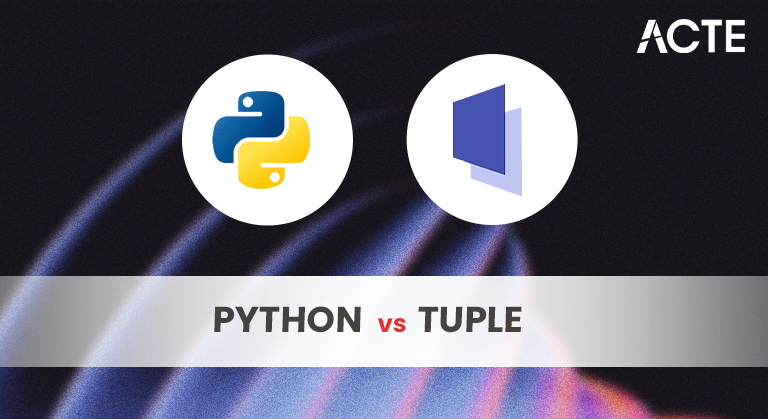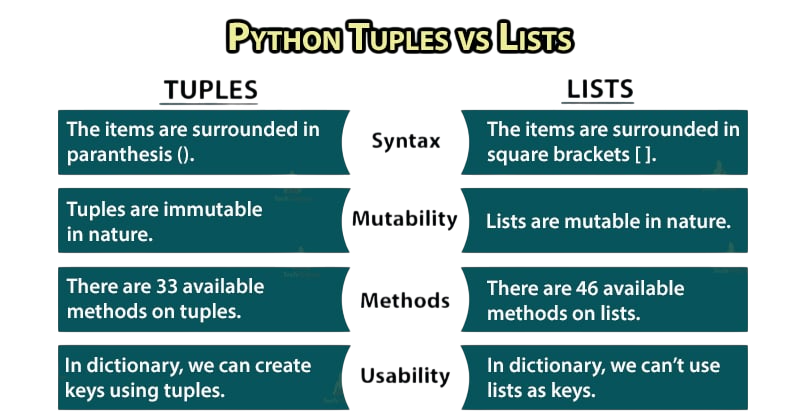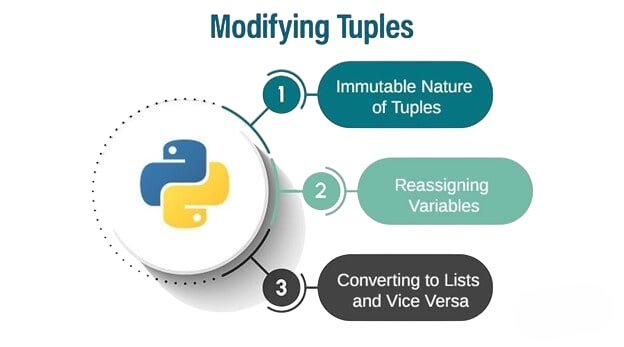
- Lists and Tuples
- Syntax Comparison
- Mutability
- Performance and Speed
- Memory Usage
- Use Cases for Lists
- Use Cases for Tuples
- Methods and Operations
- Nested Structures
- Conversions
- Common Interview Questions
- Summary
Lists and Tuples
Python, a high-level and versatile programming language, provides numerous built-in data structures that aid developers in managing, storing, and manipulating data effectively. Among these, List vs Tuple in Python is one of the most important comparisons, as they are two fundamental sequence types that allow the storage of ordered collections of elements. To master such distinctions and apply them effectively in real-world scenarios, exploring Python Training reveals how structured learning in Python equips developers to choose the right data types, optimize performance, and write clean, maintainable code, explore the key differences between List vs Tuple in Python, including syntax, performance, memory usage, use cases, and more, to help developers make informed choices in their Python projects.
Interested in Obtaining Your Python Certificate? View The Python Developer Course Offered By ACTE Right Now!
Syntax Comparison
Understanding the syntax differences between lists and tuples is the first step toward grasping their unique behaviors. Lists are created using square brackets [], such as my_list = [1, 2, 3]. This notation allows developers to create dynamic sequences that can be modified later in the program. In contrast, tuples are defined using parentheses (), as in my_tuple = (1, 2, 3). To understand how such structural precision contributes to software reliability, exploring Python Project Ideas reveals how consistent coding practices, data integrity, and testing protocols ensure that applications meet performance and usability standards. A notable exception occurs when creating a tuple with a single element Python requires a trailing comma to differentiate it from a simple parenthetical expression. For example, single_element_tuple = (1,) is a valid one-item tuple, whereas single_element_tuple = (1) is simply an integer enclosed in parentheses. This syntactical nuance ensures Python interprets the structure correctly.
Mutability
- The primary distinction between lists and tuples lies in their mutability. Lists are mutable data structures, meaning they allow in-place modifications such as adding, removing, or updating elements. This flexibility is useful in scenarios where data evolves during execution.
- For instance, elements can be appended using append(), extended with another list via extend(), or removed using remove() or pop(). Conversely, tuples are immutable. Once a tuple is defined, its elements cannot be altered, added to, or removed.
- Attempting to modify a tuple results in a TypeError. This immutability ensures data integrity and allows tuples to be used as keys in dictionaries or stored in sets, which require hashable objects. To understand how such principles of data integrity apply to hardware-software integration, exploring Python Developer Skills reveals how LabVIEW leverages structured programming and reliable data handling to build precise, scalable measurement systems.
- When it comes to performance, tuples generally have a speed advantage over lists. Since tuples are immutable, Python can optimize their internal representation and execution more efficiently.
- This means that operations involving tuples, such as iteration or lookup, are typically faster than with lists. Tuples have a smaller memory footprint and lower overhead, making them more efficient in scenarios that involve large numbers of read-only sequences.
- This performance gain is particularly important in applications where speed and resource optimization are critical, such as high-frequency trading algorithms or large-scale data processing.
- Tuples, due to their immutability, are best suited for use cases where data should remain constant. They are often used to represent fixed collections, such as coordinates (latitude, longitude), color codes (RGB), or configuration settings.
- Tuples are also common in function returns when multiple values need to be returned as a single object. This enables functions to return multiple results while ensuring that the returned values remain unchanged. Moreover, because tuples can be used as dictionary keys, they are useful in scenarios that involve mapping complex keys to values, such as caching or memoization functions.
- Lists and tuples support many similar operations, including indexing, slicing, and iteration. However, their methods differ significantly due to their mutability. Lists have numerous built-in methods such as append(), extend(), insert(), remove(), pop(), reverse(), and sort() all of which modify the list in some way.
- Tuples, on the other hand, support only two primary methods: count() and index(). These methods allow read-only operations and reflect the tuple’s role as a static data container. Despite this limitation, tuples can still be traversed and examined using standard iteration techniques, making them practical for fixed-sequence use.
- The differences between lists and tuples are frequently asked in technical interviews, especially for Python-related roles. Interviewers often ask questions like, “What is the difference between a list and a tuple in Python?”, “When should you use a tuple over a list?”, or “Can a tuple be modified after creation?” Candidates are expected to discuss mutability, performance, memory usage, and appropriate use cases.
- Some interviews may also include hands-on coding challenges that require the use of both lists and tuples, testing the candidate’s understanding of when each data structure is appropriate. Being prepared to explain and demonstrate these concepts is crucial for success in Python interviews.

Gain Your Master’s Certification in Python Developer by Enrolling in Our Python Master Program Training Course Now!
Performance and Speed
Memory Usage
Memory consumption is another area where tuples excel over lists. Because tuples are immutable, Python allocates a fixed amount of memory to them at the time of creation. This static allocation reduces memory usage and leads to faster access times. To understand how such memory optimizations impact performance and scalability, exploring Python Training reveals how mastering Python equips developers to manage resources efficiently, implement robust data structures, and write high-performance applications. Lists, however, are dynamically resizable. They require additional memory to accommodate potential changes in size and content. This flexibility results in higher memory usage, especially when dealing with large data sets. For memory-constrained environments, such as embedded systems or mobile applications, using tuples can lead to more efficient memory management.
Use Cases for Lists
Lists are ideal for scenarios where the data collection is expected to change during program execution. Their mutability allows dynamic modifications, which makes them suitable for tasks such as maintaining user inputs, implementing queues and stacks, or manipulating items in a shopping cart. Lists are also widely used in data processing applications where filtering, sorting, or transforming datasets is required. To ensure these operations remain stable under sudden load variations, exploring Python vs C++ reveals how this performance testing technique helps developers evaluate system behavior during extreme traffic surges, ensuring reliability and responsiveness in real-world scenarios. Their extensive list of built-in methods provides a rich interface for data manipulation, making them a preferred choice for tasks that involve changing data over time.
Are You Preparing for Python Jobs? Check Out ACTE’s Python Interview Questions and Answers to Boost Your Preparation!
Use Cases for Tuples
Methods and Operations

Nested Structures
Both lists and tuples support nesting, allowing the creation of complex data structures such as matrices, multi-dimensional arrays, and records. A list can contain other lists, tuples, or a mix of both, and the same applies to tuples. For example, a list of tuples might represent a collection of database records, while a tuple of lists might be used to store multiple modifiable sequences within an immutable wrapper. To understand how mastering such data structures translates into career opportunities, exploring Python Applications reveals how proficiency in backend and frontend logic including Python collections can influence earning potential across tech roles in India. The decision to nest lists or tuples should be based on whether the inner or outer structure needs to be modifiable. Nested structures provide powerful capabilities in Python, particularly in data science and machine learning applications where structured data is prevalent.
Conversions
Python offers straightforward ways to convert between lists and tuples using the list() and tuple() constructors. This is useful when working with functions or libraries that require specific data types. For example, a tuple returned from a function can be converted to a list for further modification using list(my_tuple). Conversely, a list that is no longer meant to change can be converted to a tuple using tuple(my_list). To understand how such structural clarity supports service definitions and data contracts, exploring What is WSDL in Web Services reveals how WSDL enables precise communication between systems by describing available operations, message formats, and protocols in a standardized XML format. These conversions are efficient and allow developers to take advantage of both data structures’ strengths depending on the context. Understanding when and how to perform these conversions is an essential skill in Python development.
Common Interview Questions
Summary
List vs Tuple in Python highlights that while lists and tuples share similarities as sequence data types, they are fundamentally different in their behavior and intended use. Lists offer flexibility through their mutability and a wide range of built-in methods, making them suitable for dynamic data manipulation. Tuples, being immutable, provide performance, memory efficiency, and data integrity, making them ideal for fixed collections. To explore how such properties enhance application design and data handling, diving into Python Training reveals how mastering Python equips developers to leverage tuples effectively alongside other core structures for building clean, reliable, and scalable solutions. Developers should choose the appropriate structure based on whether the data needs to change and the performance requirements of their application. A deep understanding of List vs Tuple in Python not only improves code quality but also enables the development of efficient, scalable, and maintainable programs.





